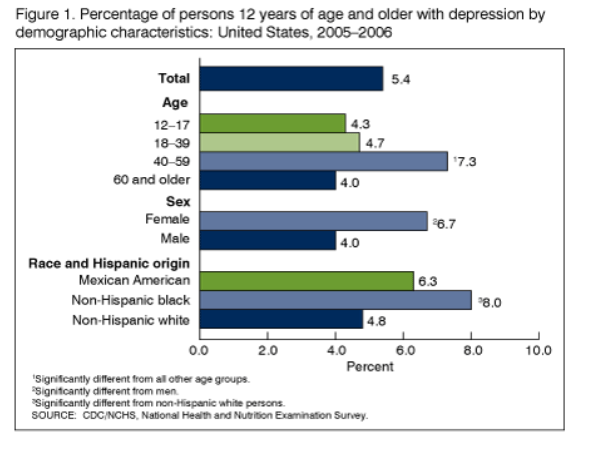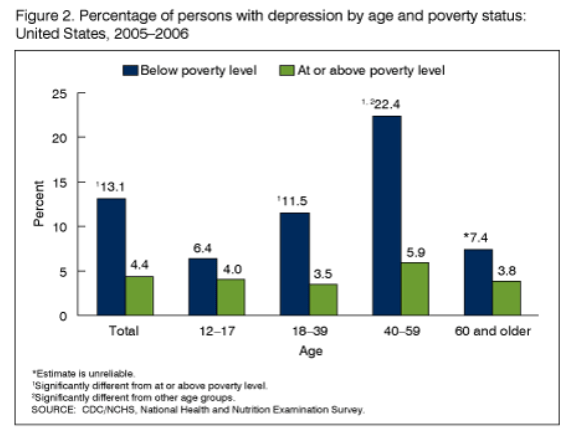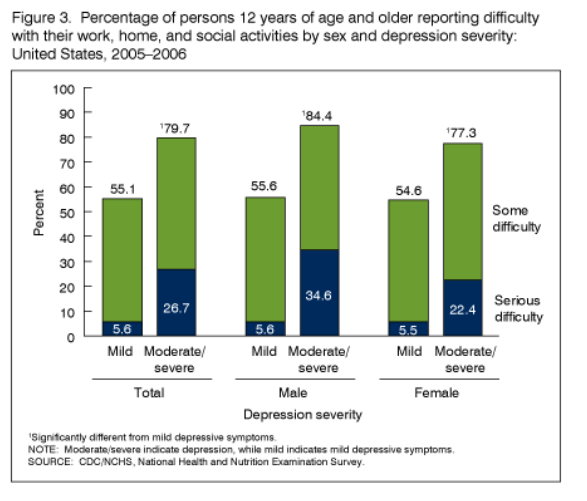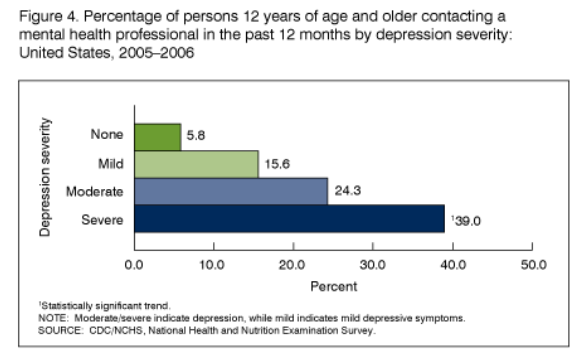| |
Depression in the United States Household Population, 2005-2006
|
| |
| |
from Jules: this article reports rates of depression in the USA and higher rates in 40-59 year olds, women, and non-Hispanic blacks. So what does this portend for people aging with HIV? Will aging HIV+ individuals face increased risk for depression. This topic is in line with recent NATAP reports raising concerns about increased risk for neurologic complications among aging HIV+ individuals, which may include concerning increased risk for Alzheimer's disease or a similar mental disease, and concern about mild to moderate cognitive impairment. Are we paying attention to this, I don't think so. As we ship $50 billion overseas for PEPFAR we appear to be neglected many domestic health concerns in the USA including ADAP, HCV coinfection, aging concerns. When will researchers and Federal officials pay adequate attention!
CDC - NCHS Data Brief
Number 7, September 2008
Laura A. Pratt, Ph.D., and Debra J. Brody, M.P.H.
Key findings
Data from the National Health and Nutrition Examination Survey, 2005-2006
* In any 2-week period, 5.4% of Americans 12 years of age and older experienced depression. Rates were higher in 40-59 year olds, women, and non-Hispanic black persons than in other demographic groups.
* Rates of depression were higher among poor persons than among those with higher incomes.
* Approximately 80% of persons with depression reported some level of functional impairment because of their depression, and 27% reported serious difficulties in work and home life.
* Only 29% of all persons with depression reported contacting a mental health professional in the past year, and among the subset with severe depression, only 39% reported contact.
Depression is a common and debilitating illness. It is treatable, but the majority of persons with depression do not receive even minimally adequate treatment (1). Depression is characterized by changes in mood, self-attitude, cognitive functioning, sleep, appetite, and energy level (2). The World Health Organization found that major depression was the leading cause of disability worldwide (3). Depression causes suffering, decreases quality of life, and causes impairment in social and occupational functioning (4). It is associated with increased health care costs as well as with higher rates of many chronic medical conditions (5). Studies have shown that a high number of depressive symptoms are associated with poor health and impaired functioning, whether or not the criteria for a diagnosis of major depression are met (6,7).
More than 1 in 20 Americans 12 years of age and older had current depression

Persons 40-59 years of age had higher rates of depression than any other age group.
Persons 12-17, 18-39, and 60 years of age and older had similar rates of depression.
Depression was more common in females than in males.
Non-Hispanic black persons had higher rates of depression than non-Hispanic white persons.
More than one out of seven poor Americans had depression
In the 18-39 and 40-59 age groups, those with income below the federal poverty level had higher rates of depression than those with higher income.
Among persons 12-17 and 60 years of age and older, rates of depression did not vary significantly by poverty status.

Depression was associated with functional impairment in many areas of life
Overall, approximately 80% of persons with depression reported some level of difficulty in functioning because of their depressive symptoms.
In addition, 35% of males and 22% of females with depression reported that their depressive symptoms made it very or extremely difficult for them to work, get things done at home, or get along with other people.
More than one-half of all persons with mild depressive symptoms also reported some difficulty in daily functioning attributable to their symptoms.

The percentage of persons who had contact with a mental health professional increased as depression severity increased
Among all people with depression - those with moderate or severe symptoms - 29% reported contact with a mental health professional.
Among those with severe depression, only 39% reported contact with a mental health professional.

Summary
Depression is an episodic condition. People have an episode of depression, get well, and may or may not have another episode later in their life. In 2005-2006, in any 2-week period, 5.4% of Americans 12 years of age and older had depression. Females, people 40-59 years of age, non-Hispanic black persons, and people living below the poverty level had higher rates of depression than their respective counterparts. Depression is a condition that causes impairment in many areas of functioning - including school, work, family, and social life. Approximately 80% of people with depression reported that their symptoms interfered with their ability to work, maintain a home, and be socially active. Reflecting this high rate of functional impairment, almost two-thirds of the estimated $83 billion that depression cost the United States in the year 2000 resulted from lowered productivity and workplace absenteeism (8).
Depression is a treatable condition. Successful depression treatment enables people to return to the level of functioning they had before becoming depressed. Despite the availability of treatment for depression, only 39% of people with severe depression reported contacting a mental health professional in the past year.
There are many reasons people with depression do not receive treatment. Some do not realize they have an illness that can be treated. Others do not believe treatment works. Other barriers to treatment include the stigma surrounding mental illness and mental health treatment and lack of insurance coverage for mental health care. (9). Depression is a major public health problem, and increasing the number of Americans with depression who receive treatment is an important public health goal and a national objective of Healthy People 2010 (10). Further discussion of ways to reach this goal can be found in Mental Health: A Report of the Surgeon General, Chapter 8, "A Vision for the Future" (9).
Definitions
Major depression is a clinical syndrome of at least five symptoms that cluster together, last for at least 2 weeks, and cause impairment in functioning. Mood symptoms include depressed, sad or irritable mood, loss of interest in usual activities, inability to experience pleasure, feelings of guilt or worthlessness, and thoughts of death or suicide. Cognitive symptoms include inability to concentrate and difficulty making decisions. Physical symptoms include fatigue, lack of energy, feeling either restless or slowed down, and changes in sleep, appetite, and activity levels (2).
Depression was measured in the National Health and Nutrition Examination Surveys (NHANES) using the Patient Health Questionnaire (PHQ-9), a nine-item screening instrument that asks questions about the frequency of symptoms of depression over the past 2 weeks (11). Response categories "not at all," "several days," "more than half the days" and "nearly every day" were given a score ranging from 0 to 3. A total score was calculated ranging from 0 to 27. Depression was defined as a PHQ-9 score of 10 or higher, a cut point that has been well validated and is commonly used in clinical studies that measure depression (11).
It is possible that severely depressed persons disproportionately chose not to participate in the survey or health examination, which included administration of the PHQ-9; therefore, the prevalence estimates in this report may slightly underestimate the actual prevalence of depression. In addition, people who were being successfully treated for depression would not be identified as depressed by the PHQ-9.
Depression severity was defined by various cut points from the total score from the PHQ-9 screening instrument (11). Scores on the PHQ-9 can be classified as follows:
* 0-4 No, minimal
* 5-9 Mild
* 10-14 Moderate
* 15-19 Moderately severe
* 20-27 Severe
In this report, scores of 15 or higher were termed severe depression.
Functional impairment was defined by the question: "How difficult have these problems made it for you to do your work, take care of things at home, or get along with other people?" Only persons who had a score of 1 or more on the PHQ-9 symptom questions were asked the impairment question. Responses were scored from 0 (not at all difficult) to 3 (extremely difficult). A score of 1 or more was defined as any functional impairment. A score of 2 or 3 suggests moderate to severe functional impairment.
Contact with a mental health professional was defined by the question: "During the past 12 months, have you seen or talked to a mental health professional such as a psychologist, psychiatrist, psychiatric nurse, or clinical social worker about your health?"
The data do not indicate whether persons who contacted a mental health professional actually began treatment for depression. The question also does not ask about mental health treatment received from primary care providers.
Data sources and methods
NHANES is a continuous cross-sectional survey of the civilian, noninstitutionalized U.S. population designed to assess the health and nutrition of Americans. Persons living in institutions, where rates of depression are higher than in the community-dwelling population, are not included in NHANES. Survey participants are asked to complete a household interview and an examination in a mobile examination center (MEC) that included a private interview. The annual interview and examined sample includes approximately 5,000 persons of all ages. In 2005-2006, black and Mexican-American persons, adults 60 years and older, and low income persons were oversampled to improve the statistical reliability of the estimates for these groups.
This report was based on the analysis of household and MEC interview data. The question about contact with a mental health professional was asked in the household interview and the PHQ-9 depression questions were asked in the MEC. For 12-15 year olds, a proxy respondent, usually one of the child's parents, answered the questions in the household interview; however, during the private interview in the MEC, youths answered questions for themselves. The questions related to depression were administered in English and Spanish.
The NHANES sample examination weights, which account for the differential probabilities of selection, nonresponse, and noncoverage, were used for all analyses. Standard errors of the percentages were estimated using Taylor series linearization, a method that incorporates the sample design and sample weights.
Differences between subgroups were evaluated using the univariate t-statistic. A test for trend was done to evaluate estimates of contact with a mental health professional by depression severity. All significance tests were two-sided using p<0.05 as the level of significance. All comparisons reported in the text are statistically significant unless otherwise indicated. Data analyses were performed using SAS version 9.1 (SAS Institute, Cary N.C.) and SUDAAN version 9.0 (RTI, Research Triangle Park, N.C.).
About the authors
Laura Pratt is with the Centers for Disease Control and Prevention's National Center for Health Statistics, Office of Analysis and Epidemiology. Debra Brody is with the Centers for Disease Control and Prevention's National Center for Health Statistics, Division of Health and Nutrition Examination Surveys.
References
1. Wang PS, Lane M, Olfson M, Pincus HA, Wells KB, Kessler RC. Twelve-month use of mental health services in the United States: Results from the National Comorbidity Survey Replication. Arch Gen Psychiatry 62:629-40. 2005.
2. American Psychiatric Association. Diagnostic and statistical manual of mental disorders, 4th ed. American Psychiatric Association: Washington, DC. 2000.
3. Lopez AD, Murray C. The global burden of disease, 1990-2020. Nature Med 4(11):1241-3. 1998.
4. Wells KB, Stewart A, Hays RD, Burnam MA, Rogers W, Daniels M, et al. The functioning and well-being of depressed patients: Results from the Medical Outcomes Study. JAMA 262, 914-9. 1989.
5. Katon WJ. Clinical and health services relationships between major depression, depressive symptoms and general medical illness. Biol Psychiatry 54:216-26. 2003.
6. Broadhead WE, Blazer DG, George LK, Tse CK. Depression, disability days, and days lost from work in a prospective epidemiologic survey. JAMA 21:264(19):2524-8. 1990.
7. Wagner HR, Burns BJ, Broadhead WE, Yarnall KSH, Sigmon A, Gaynes BN. Minor depression in family practice: Functional morbidity, co-morbidity, service utilization and outcomes. Psychol Med 30:1377-90. 2000.
8. Greenberg PE, Kessler RC, Birnbaum HG, et al. The economic burden of depression in the United States: How did it change between 1990 and 2000? J Clin Psychiatry 64(12):1465-75. 2003.
9. Office of the Surgeon General. Mental Health: a report of the Surgeon General. Department of Health and Human Services: Washington, DC. 1999. Available from: http://www.surgeongeneral.gov/library/mentalhealth/home.html.
10. U.S. Department of Health and Human Services. Healthy People 2010. Washington, DC: U.S. Department of Health and Human Services. 2000. Available from: http://www.healthypeople.gov/document/html/objectives/18-09.htm.
11. Kroenke K, Spitzer RL, Williams JBW. The PHQ-9: validity of a brief depression severity measure. J Gen Int Med 16:606-13. 2001.
|
|
| |
| |
|
|
|